
USS Fairfax (DD-93) was a Wickes-class destroyer in the United States Navy during World War I, later transferred for World War II service first to the Royal Navy as HMS Richmond (G88), a Town-class destroyer, and then to the Soviet Navy as Zhivuchy.
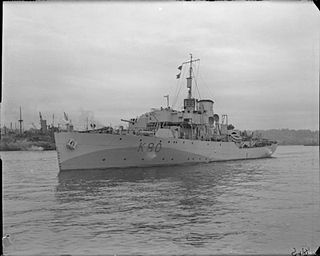
HMS Bluebell was a Flower-class corvette that served in the Royal Navy in World War II. Ordered from Fleming & Ferguson of Paisley, Scotland on 27 July 1939, she was launched on 24 April 1940 and commissioned in July 1940. She served in the Atlantic, Mediterranean and Arctic campaigns, escorting several convoys to Russia, and also took part in the invasions of Sicily and France. She was torpedoed and sunk by U-711 in the Kola Inlet on 17 February 1945 while escorting the convoy RA-64 from Murmansk. Only one member of her crew survived.

HMCS Algonquin was a V-class destroyer, laid down for the Royal Navy as HMS Valentine (R17) and transferred to the Royal Canadian Navy on completion during the Second World War. She saw service in the Second World War escorting the aircraft carriers that bombed the Tirpitz in March 1944 and providing naval gunfire support to the Normandy landings. The destroyer was to participate in the Pacific Campaign but the war ended before her arrival in that theatre. Algonquin was converted in 1953 to a frigate and spent the majority of her remaining career in the Atlantic, being paid off in 1970.

HMCS Sioux was a V-class destroyer of the Royal Canadian Navy which fought in the Second World War and the Korean War. She was launched as HMS Vixen for the British Royal Navy before being transferred to the Royal Canadian Navy. She was then named for the Sioux people of Canada's western provinces.
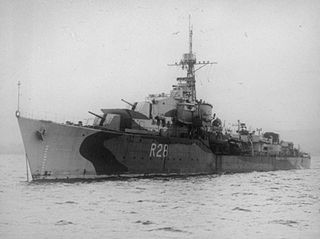
HMS Verulam was a V-class destroyer of the British Royal Navy that saw service during the Second World War.
Empire Carpenter was a 7,025 GRT cargo ship which was built in 1942 for the Ministry of War Transport (MoWT). In 1944 she was leased to the Soviet Union and renamed Dickson. In 1946, she was returned to the United Kingdom and regained her former name of Empire Carpenter. She was sold in 1947 and renamed Petfrano. In 1955, she was sold to Panama owners and renamed Amipa, further sales saw her renamed Apex. In 1968, she was sold to Cypriot owners and renamed Afros, serving until scrapped in 1971.

SS Empire Celia was a 7,025 GRT cargo ship built in 1943 by Charles Connell and Company Ltd of Scotstoun, Glasgow for the Ministry of War Transport (MoWT). In 1948 she was sold into merchant service and renamed Putney Hill. Further name changes were Castle Hill in 1949 and London Statesman in 1950. In 1951 she was sold to Panamanian owners and renamed Morella, being sold later that year to Polskie Linie Oceaniczne and renamed Jedność. She served until 1966, when she was scrapped.
Convoy RA 55A was an Arctic convoy during World War II. It was one of a series of convoys run to return Allied ships from Soviet northern ports to ports in Britain. It sailed in late December 1943, reaching British ports at the end of the month. All ships arrived safely.
Convoy JW 54A was an Arctic convoy sent from Great Britain by the Western Allies to aid the Soviet Union during World War II. It sailed in November 1943, reaching the Soviet northern ports at the end of the month. JW 54A was the first out-bound Arctic convoy of the 1943–44 winter season, following their suspension during the summer. All ships arrived safely.
Convoy JW 51A was an Arctic convoy sent from Great Britain by the Western Allies to aid the Soviet Union during World War II. It sailed in December 1942, reaching the Soviet northern ports at the end of the month.
Convoy JW 51B was an Arctic convoy sent from United Kingdom by the Western Allies to aid the Soviet Union during World War II. It sailed in late December 1942, reaching the Soviet northern ports in early January 1943.
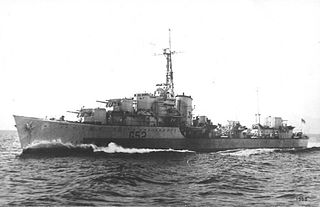
HMS Matchless was a M-class destroyer built during World War II. After the war she placed in reserve until August 1957 and eventually sold to the Turkish Navy, who renamed her TCG Kılıç Ali Paşa. She was struck from the Turkish Navy list and scrapped in 1971.

HMS Tortola (K595) was a Colony-class frigate of the United Kingdom that served during World War II. She originally was ordered by the United States Navy as the Tacoma-class patrol frigateUSS Peyton (PF-91) and was transferred to the Royal Navy prior to completion.

The second HMS Essington (K353), and the first ship of the name to see service, was a British Captain-class frigate of the Royal Navy in commission during World War II. Originally constructed as a United States Navy Buckley-class destroyer escort, she served in the Royal Navy from 1943 to 1945.
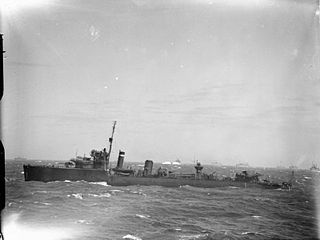
HMS Walker (D27) was a W-class destroyer of the British Royal Navy that saw service in the final months of World War I, in the Russian Civil War and in World War II.

HMS Whitehall, pennant number D94, later I94, was a Modified W-class destroyer of the British Royal Navy that saw service in the Second World War.
George Cunningham Leslie CB OBE was a senior Royal Naval officer who joined the Royal Navy in 1938. He saw extensive service during the Second World War and in the postwar Royal Navy. He retired with the rank of rear admiral in 1970.
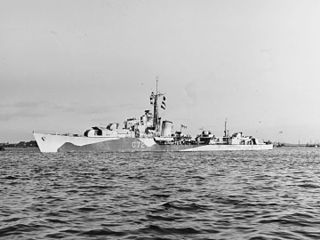
HMS Scorpion was an S-class destroyer of the Royal Navy, the eleventh of her name, commissioned on 11 May 1943. Initially she was to be named Sentinel, but this was changed following the loss of the Dragonfly-class river gunboatScorpion in the Bangka Strait in February 1942. She served in the Royal Navy during the Second World War, mostly in the Arctic Ocean, and fought in the Battle of North Cape. She was sold to the Netherlands in 1945 and scrapped in 1963.

HMS Dianella was a Flower-class corvette of the Royal Navy. She served during the Second World War.

HMS Serapis was an S-class destroyer of the British Royal Navy. The ship was built by Scotts Shipbuilding and Engineering Company from 1941 to 1943, and was launched on 25 March 1943 and completed on 25 December 1943.













